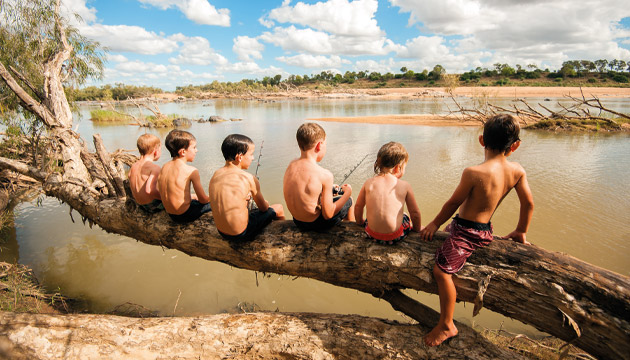From wetting a line in an outback creek to vast aquaculture farms, fishing in Australia is a much-loved pastime and an increasingly sustainable industry worth more than $5 billion a year.
Story Mandy McKeesick Photo Debbie Scott
Dirranbandi, in southern Queensland, has been in drought for as long as locals care to remember, which does not bode well for its annual Easter fishing competition. But, undeterred, more than 250 people have turned up to the Balonne River to camp under canvas and in caravans. Urban relatives visit country cousins and grey nomads have escaped the hectic holiday traffic to park under river gums.
Camp fires smoke, tall tales are told, lines are rigged, new friendships are formed and stubbies are cracked. Sometimes fishing transcends the fish.
Rhonda Houlahan grew up in Dirranbandi and is holding court over a tribe of children and grandchildren on the riverbank. “The fishing is nothing like it was,” she says, looking at the one yellowbelly and two carp that comprise their morning’s catch, “but it gets me out of the house and I can come and sit down here with my family.”
Anyone who has wet a line in an inland river, sat upon a wharf or fought seasickness on a small boat over the continental shelf will have their own fishing tale. There are great yarns from other eras, such as the story of Old Tom, the orca (killer whale) who would splash and cavort before the whaling stations of Eden on the New South Wales South Coast in the 1850s, alerting whalers to the presence of a baleen whale. Imagine a slight man standing precariously on the rocking bow of a 10-metre rowboat, ready to harpoon a 15m humpback, while Tom and his mates added to the melee.
Before white whalers, the Yuin people worked with the orcas, and Indigenous people fished across the country, from the fish traps of Brewarrina in NSW to complex eel aquaculture at Budj Bim in Victoria, recently added to the UNESCO World Heritage List. “We followed the fish breeding cycles and learnt the bush tells you about the sea,” says Indigenous educator and Yuin elder Noel Butler. “Like right now [autumn] the bloodwood is flowering, so it is mullet season. We knew what the fish were doing and we got to know the coastline – knew the depth of gutters and what nets to use, how to hang a net and what mesh size.” Fish hooks were made from shell, spearheads from bone; eel traps and fishing bags were woven from native grasses; fishing spears were fashioned from the flower spikes of grasstrees, which floated, “because if you missed, someone had to go in and get it,” Noel says.
The earliest recorded fishing industries were Indigenous. The people of northern Australia traded trepang (sea cucumber) fishing rights with the Macassans (Indonesians). Today, it is estimated the recreational fishing industry alone contributes $2.5 billion to the Australian economy, and the latest Australian Bureau of Agricultural and Resource Economics (ABARES) figures report the gross annual value of wild-caught and aquaculture production to be $3 billion. In comparison, the Australian beef and cattle industry was valued at $16.8 billion during the same period.
In terms of tonnage, Australia produced a touch over 255,000 tonnes of fish in 2016–2017, with farmed salmon in Tasmania accounting for 20 percent of this.
This story excerpt is from Issue #126
Outback Magazine: Aug/Sep 2019










